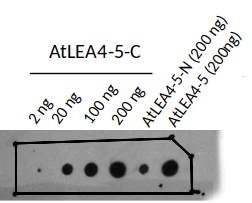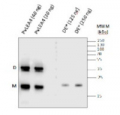1

Anti-LEA4-5 (78-158) | Late embryogenesis abundant protein 4-5 (C-terminal)
AS22 4831 | Clonality: Polyclonal | Host: Rabbit | Reactivity: Arabidopsis thaliana
- Product Info
-
Immunogen: Part of a recombinant Arabidopsis thaliana LEA4-5, corresponding to position 78-158, UniProt: Q9FG31 , TAIR: AT5G06760 Host: Rabbit Clonality: Polyclonal Purity: Serum Format: Lyophilized Quantity: 50 µl Reconstitution: For reconstitution add 50 µl of sterile water Storage: Store lyophilized/reconstituted at -20°C; once reconstituted make aliquots to avoid repeated freeze-thaw cycles. Please remember to spin the tubes briefly prior to opening them to avoid any losses that might occur from material adhering to the cap or sides of the tube. Tested applications: Western blot (WB) Recommended dilution: 1 : 2000 (WB) Expected | apparent MW: 16 kDa
- Reactivity
-
Confirmed reactivity: Arabidopsis thaliana Predicted reactivity: Species of your interest not listed? Contact us Not reactive in: No confirmed exceptions from predicted reactivity are currently known - Application Examples
-

The amount of purified protein or peptide used in these dot blot experiments is indicated in the scheme on the right side of the image (2 ng to 200 ng). As specificity controls, we used 200 ng of purified AtLEA4-5 and of a peptide corresponding to the AtLEA4-5 C-region. In all cases equal volumes of the different samples were dotted on Nitrocellulose Blotting Membrane 0.45 µm Amersham TM Protran TM Premium. Once samples were dry, membranes were blocked with non-fat milk 5% (W/V) during eight hours at 4°C with agitation. Blots were incubated with primary antibody at the indicated dilution for two days at 4°C with slow agitation. The antibody solution was decanted, and blots were rinsed briefly, then washed once for 15 min and 2-times for 5 min in TBS-T at room temperature (RT) with agitation. Subsequently, blots were incubated with secondary antibody (anti-rabbit IgG horse radish peroxidase conjugated) diluted to 1:10 000 for 8 h at RT with agitation. The blot was washed as described above and developed for 2 min with using chemiluminescent detection reagent according to manufacture recommendations.. Exposure time was 60 seconds.
Courtesy of Dr. Alejandra A. Covarrubias,Universidad Nacional Autónoma de México, Mexico
- Background
-
Background: LEA (Late embryogenesis abundant) proteins are very hydrophilic proteins, described over 25 years ago as accumulating during late stages of plant seed development. Found in vegetative plant tissues following exposure to environmental stress. Synonymes: Putative late embryogenesis abundant protein LEA.
- Product Citations
-
Selected references: Romero-Pérez et al. (2024). Self-association and multimer formation in AtLEA4-5, a desiccation-induced intrinsically disordered protein from plants. Protein Sci. 2024 Nov;33(11):e5192. doi: 10.1002/pro.5192. - Protocols
-
Agrisera Western Blot protocol and video tutorials
Protocols to work with plant and algal protein extracts
Agrisera Educational Poster Collection - Reviews:
-
This product doesn't have any reviews.



